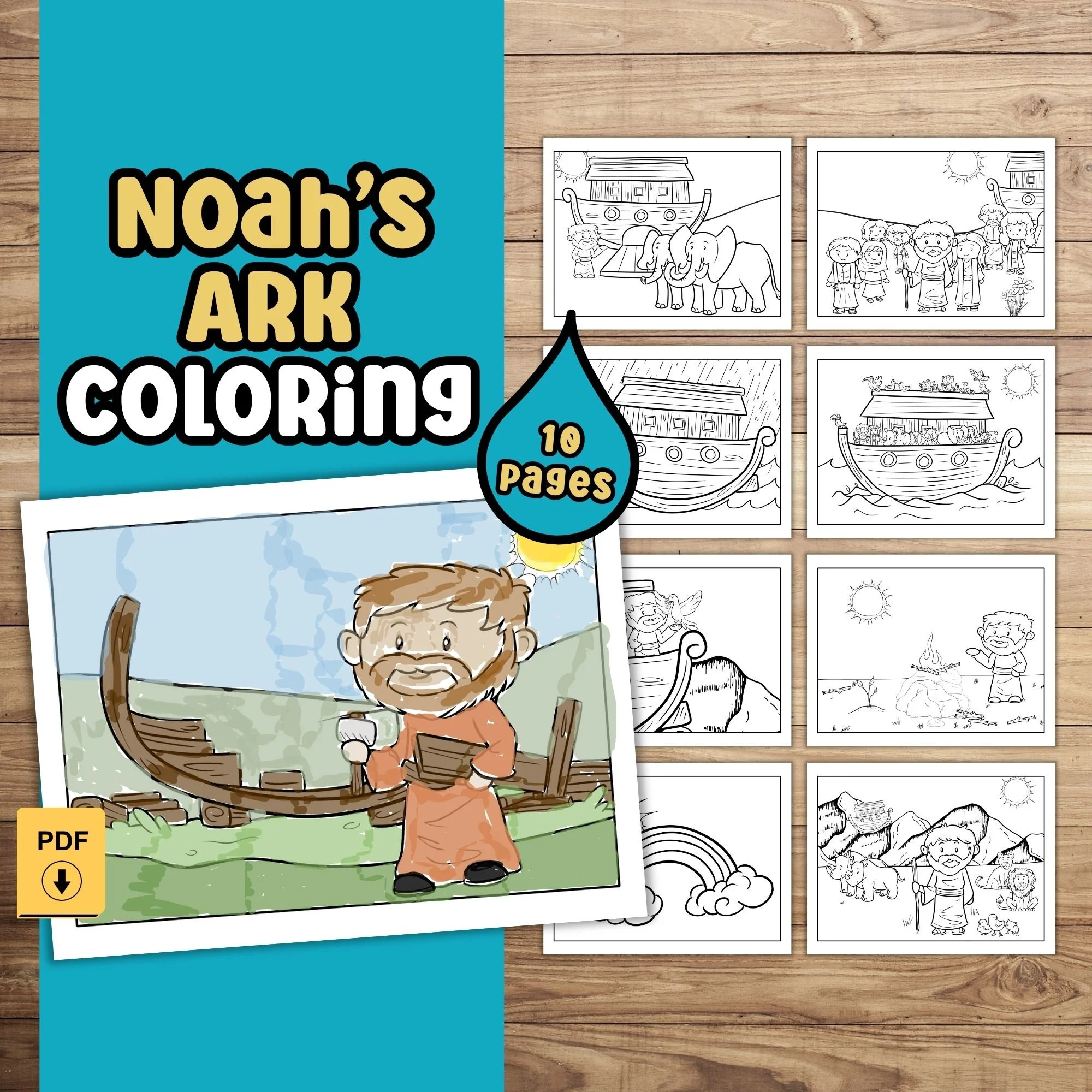8 Noah and the Flood Facts That Might Surprise You
Bible Truths, Science Wonders, and Fun Learning for Kids
The story of Noah and the flood is one of the most captivating Bible stories for children. From pairs of animals boarding a massive boat to a rainbow promise stretching across the sky, Noah’s Ark captures the imagination and teaches timeless lessons about trust, obedience, and God’s faithfulness. But beyond the coloring pages and nursery rhymes, this story is a deep well of biblical truth, historical insight, and even scientific wonder.
Whether you're a Christian homeschooling parent, a Sunday school teacher, or simply looking for faith-filled ways to engage your kids, this post will unpack surprising facts about Noah’s Ark that reveal God’s wisdom in design and how faith and science are not in opposition—they beautifully complement each other.
So how well do you really know the story of Noah and the Flood?
Quick Noah's Ark Quiz: Can You Answer These?
How many chapters in the Bible tell the story of Noah and the flood?
How long was Noah on the ark?
How many of each bird did Noah take on the ark?
What kind of wood did God tell Noah to use?
How did Noah know when it was safe to leave the ark?
What was the first thing Noah did after the flood?
How big was the ark?
What does the rainbow mean in God's promise?
Got your guesses?
Let’s dive deeper and uncover the incredible truths behind each answer—along with the science that affirms God’s amazing design.
1. How Many Chapters Cover the Story of Noah and the Flood?
The story of Noah and the flood spans four chapters in the Bible—Genesis 6 through Genesis 9. Interestingly, the narrative is repeated in a layered way. It's not just a chronological tale; it's told three times with increasing detail.
Each version emphasizes different truths: Noah’s righteousness and obedience, God’s justice and mercy, and God’s covenant with all living creatures.
🔬 Science Insight 🔬
This storytelling method reflects how science builds understanding: layer by layer. Scientists retest theories and add new details over time, just as Scripture gives us multiple angles to understand divine truth. It's a perfect reminder that repetition reinforces reasoning—whether in a lab or in the Bible study.
2. How Long Was Noah on the Ark?
Most kids know the flood lasted 40 days and 40 nights. But that was just the beginning! According to Genesis 7:11 and 8:14, Noah was on the ark for one year and ten days.
The rain fell for 40 days.
The floodwaters remained for 150 days.
It took months for the waters to recede.
Noah waited for God's command to leave the ark, even after the ground appeared dry.
🔬 Science Insight 🔬
This timeline is consistent with flood drainage dynamics we observe today. In major floods, waters can take months to fully recede. Noah's patience shows faith in God's timing—and also reflects the natural rhythm of restoration in an ecosystem after a catastrophe.
3. How Many of Each Bird Did Noah Take?
Genesis 7:2-3 tells us that Noah brought seven pairs of each kind of clean bird and one pair of each unclean bird. Why so many birds?
Clean birds were used for sacrifices.
Birds played a crucial role in restoring the earth after the flood.
🔬 Science Insight 🔬
Birds are essential to seed dispersal and soil revival. When birds eat fruits, the seeds pass through their digestive systems, which softens the seed coat. Once released in their droppings, these seeds are more likely to sprout. Birds literally helped replant and restore the world! Just the way God designed it.
4. What Kind of Wood Did Noah Use?
God told Noah to use gopher wood (Genesis 6:14). This term appears only once in the Bible, so its exact identity is unknown. Scholars believe it could have been a type of resinous, water-resistant wood like cypress or cedar.
🔬 Science Insight 🔬
Cypress and similar woods are still used in boat-building today due to their durability, density, and decay resistance. Ancient shipbuilders also favored these woods. God didn’t just choose any wood—He selected the best material for a seaworthy vessel. His instructions were both spiritually significant and scientifically smart.
5. How Did Noah Know It Was Safe to Leave?
Noah released a raven first, then a dove (Genesis 8:6-12). When the dove returned with a fresh olive leaf, it was a sign that vegetation had begun to grow. Later, when it didn’t return, Noah knew it had found a home.
🔬 Science Insight 🔬
Today, scientists still study bird behavior to track environmental changes. Doves won’t nest unless conditions are favorable—dry ground, food, and vegetation. Noah was essentially using early environmental testing, relying on animals’ natural instincts to observe the world. Creation was giving him clues, just like it still does for scientists.
6. What Was the First Thing Noah Did After the Flood?
As soon as he stepped off the ark, Noah built an altar and offered a burnt sacrifice to God (Genesis 8:20). It was an act of gratitude, worship, and trust.
🔬 Science Insight 🔬
God had Noah bring extra clean animals for this very reason. The act of worship was built into the preservation of species. This shows God’s foresight in planning for both spiritual renewal and species survival. It’s a wonderful example of how divine commands serve multiple meaningful purposes.
7. How Big Was the Ark?
Genesis 6:15 gives us the dimensions: 300 cubits long, 50 cubits wide, and 30 cubits high.
That’s approximately 450 feet long, 75 feet wide, and 45 feet tall.
It had three decks and over 100,000 square feet of floor space.
🔬 Science Insight 🔬
These dimensions create a 30:5:3 ratio, which was first used in the 1600s by Dutch shipbuilders. They discovered the ark’s ratio provided optimal stability, strength, and seaworthiness. By the 1900s, nearly every large ship followed this proportion. God gave Noah brilliant boat-building blueprints long before maritime science confirmed them.
8. What Does the Rainbow Mean?
The rainbow is God’s sign of His covenant with man (Genesis 9:13-17). He promises to never again destroy the earth with a flood. More than that, it's a symbol of mercy and renewal.
🔬 Science Insight 🔬
Rainbows form when sunlight refracts and reflects through water droplets in the atmosphere. While we understand the physics, the meaning behind the rainbow is what makes it truly miraculous. It's a natural phenomenon that God uses as a spiritual symbol—another beautiful overlap of divine truth and design.
Final Thoughts: Faith, Science, and God's Perfect Design in the Story of Noah and the Flood
The story of Noah’s and the Flood is more than just about animals and rainbows—it’s a rich narrative that shows how faith and science are beautifully connected through God’s design.
From wood types and bird behavior to ship ratios and seed dispersal, God's instructions to Noah weren’t just spiritual—they were scientifically sound, practical, and awe-inspiring. The more we study both Scripture and creation, the more we see how they reflect the same truth: God is wise, intentional, and trustworthy.
Make the story come alive with hands-on Christian resources your kids will love:
Noah and the Flood Bible Escape Room:
Dive into a fun and faith-filled adventure with this Bible Escape Room for Kids featuring a Noah’s Ark Escape Room! Perfect for Christian Kids Bible Puzzle Activity, this interactive Noah and the Flood Ark Puzzle Escape Room is ideal for Sunday School or family game night.
Noah’s Ark Coloring Pages with Bible Verses:
Explore the story of faith and promises with this Kids Bible Coloring Book featuring the Noah and the Flood Bible Story! Perfect for Sunday School, Homeschool Lessons, or teaching about the Flood. Kids will love learning how God Keeps His Promise with the symbol that remind us of this promise: the Rainbow.
Noah’s Ark Coloring Pages Without Verses:
Introduce young learners to God’s promises with this Noah’s Ark Coloring Book designed for little learners. Perfect for Sunday School activities or Preschool learning. This Flood Bible coloring page highlights the Rainbow as a sign of God’s Promise.
Noah's Ark Animal ABC Book:
Keep learning alive this summer with these Kindergarten Letter Alphabet Activities for Kids Printable Worksheets! With a fun Noah's Ark Animals theme, your child can practice letter tracing while reinforcing their ABCs. Prevent the summer slide with these engaging, faith-filled activities perfect for home or church use! 225 pages of alphabet fun for little ones.





